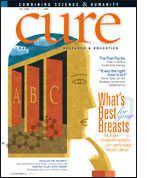Publication
Article
CURE
Message from the CURE Staff
Author(s):
Expanding coverage across the entire cancer continuum.
In this issue of CURE you’ll see some changes that address our commitment to bring you the best and most up-to-date information for the cancer journey—all of it.
First you’ll see that we have expanded our departments to include more survivorship issues that begin the day treatment ends and stay with you for the remainder of your life. The growing recognition of long-term physical issues for the estimated 12 million cancer survivors in the United States points to the importance of understanding the risk versus benefit of treatment choices made at the time of diagnosis.
The debut of our Healing Well department explores research on survivorship presented at the biennial meeting of the National Cancer Institute’s Office of Cancer Survivorship that shows how a significant percentage of survivors suffer from fatigue, fear of recurrence, and sleep disturbances even a decade beyond the end of treatment.
Healing Well will help you understand the issues that come with long-term survivorship at five, 10, or even 20 years post-treatment, as you find that, physically and emotionally, cancer remains a part of your life—and that of your family.
The Moving On department, which has traditionally looked at factors that arise immediately post-treatment, will now encompass the time called re-entry—the few years after treatment ends when you’re trying to find your footing in a new world where getting back to normal means getting back to a “new normal.”
This expansion of post-treatment information means CURE now covers the entire cancer continuum, a phrase we are hearing more and more from the cancer community that describes the time from diagnosis through survivorship, taking into account that some cancer patients remain on treatment for years. These “chronic cancer” patients add a new category to survivorship that needs to be addressed, as do those who are living with the unique issues of metastatic cancer.
We know, as you do, that the role of cancer changes at the end of treatment, but it doesn’t go away. We also know that each person with cancer, along with family and friends, travel a unique path that is decided by treatment choices, the support system, and myriad other factors.
We’ve also made some other changes to address what we see as your needs and wants. We have added a one-page department called Side Note to address coping with the side effects of cancer and its treatment. And you’ll see more information on complementary therapies throughout the magazine because we know it’s a topic of interest to many of you. Also, a newly designed curetoday.com will launch this fall.
Plus, this October, CURE will publish a special issue dedicated solely to cutting-edge treatment advances in the fight against cancer. In a recent survey of CURE readers, a whopping 82 percent of you told us you want even more information about the newest treatment options. And that’s exactly what you’ll get in this special issue as we explore the current challenges in oncology, why innovation is needed, and the specific advances that are changing the treatment landscape for all cancers.
It’s hard to believe that some of you began reading CURE when you were diagnosed in 2002, the year the magazine was born, which means you have been with us through treatment and into survivorship. This new format means we will be here for you for a long time to come, and will continue to provide you with the best and most up-to-date cancer information. And we all know that the most powerful tool against cancer is knowledge.
— The CURE Team
adfadf






